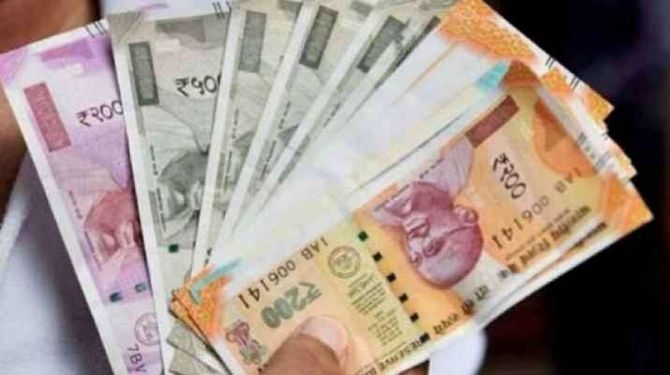Rupee opens flat against the dollar, inflation data awaited

Rupee opens flat against the dollar, inflation data awaited
On September 11, the Indian Rupee (INR) opened with minimal change against the US Dollar (USD), with the exchange rate holding steady at 82.95 to a dollar. This represented a marginal increase of 0.01 percent compared to its previous closing rate of 82.94 INR per USD.
Market analysts were closely focused on the upcoming release of key consumer price inflation (CPI) data scheduled for September 12. This data release was of particular significance due to the recent upward trend in global crude oil prices, which can exert upward pressure on inflation rates. According to a Bloomberg poll, it was anticipated that India’s CPI for the month of August would come in at 7.1 percent. This figure would represent a slight decrease from the 7.44 percent CPI recorded in the previous month of July.
The anticipation of this CPI data reflects its potential impact on currency markets and monetary policy decisions. A higher-than-expected inflation rate could influence the Reserve Bank of India (RBI) in its decision-making regarding interest rates and monetary policy measures. Therefore, currency traders and investors closely monitored this data release as it could provide valuable insights into the future direction of the Indian Rupee’s exchange rate and overall market sentiment.
Inflation data plays a crucial role in shaping market expectations and influencing central bank policies, including decisions related to interest rates. The expected decline in CPI, if realized, could have implications for the Reserve Bank of India’s monetary policy and could impact the currency’s exchange rate as well.
Overall, the minimal change in the INR’s value on September 11 suggests a cautious approach by currency traders as they awaited the release of critical inflation figures and assessed their potential impact on market dynamics.
Amit Pabari, an analyst at CR Forex, has expressed optimism about the Indian Rupee’s (INR) potential for gradual strengthening in the coming period. He cites several key factors contributing to this positive outlook, including India’s robust economic growth, strong PMI (Purchasing Managers’ Index) numbers, increased foreign investment, and the upcoming festive season.
Amit Pabari’s assessment suggests that, taking into account various positive factors, the Indian Rupee (INR) has the potential to appreciate against the US Dollar (USD) in the near term. He envisions the INR strengthening to levels between 82.50 and 82.20 INR per USD. This projection reflects an expectation for the INR to gain value in the foreseeable future.
Pabari highlights an example from September 8, when the INR was initially trading around 83.15 per USD. However, the currency received support from a state-run bank’s proactive selling of dollars, a move that is likely attributed to the intervention of the Reserve Bank of India (RBI). This intervention played a role in bolstering the INR’s value and contributing to its strengthening.
The intervention by the RBI in currency markets is a common strategy employed by central banks to stabilize or influence exchange rates. In this case, the central bank’s action likely aimed to support the INR and prevent excessive depreciation. Such interventions can have a notable impact on short-term exchange rate movements, as observed in the strengthening of the INR following the bank’s intervention.
Analysts have observed that the Reserve Bank of India (RBI) has been actively intervening in the currency markets to support the Indian Rupee (INR) whenever it approaches the range of 82.80 to 83.10 against the US Dollar (USD). This intervention has played a role in preventing the INR from depreciating to those levels again, signaling the central bank’s commitment to maintaining stability in the currency markets.
In the broader Asian currency markets, several regional currencies were trading higher on the day. The Japanese yen saw a notable rise of 0.92 percent, while the China Offshore yuan, Thai Baht, Chinese renminbi, Singaporean dollar, and Taiwanese dollar also experienced gains, albeit to varying degrees. However, the Indonesian rupiah showed a modest decline of 0.21 percent.
The US Dollar Index, a key indicator that measures the strength of the US dollar against a basket of major global currencies, was trading at 104.73. This figure represented a decline of 0.34 percent from its previous closing level of 105.09. A lower value for the dollar index indicates a relative weakening of the US dollar when compared to its major counterparts in the basket of currencies.
Currency markets are influenced by a multifaceted interplay of factors, including economic data releases, central bank policies and actions, geopolitical events, and overall market sentiment. In the case of the Indian Rupee (INR) and its exchange rate against the US Dollar (USD), the active involvement of the Reserve Bank of India (RBI) in the currency markets has a significant impact.
The RBI’s interventions, along with broader global market dynamics and developments, contribute to the fluctuations and movements observed in currency exchange rates. These factors collectively shape the behavior of the INR against the USD and impact the overall currency market landscape. Currency traders and investors closely monitor these variables to make informed decisions and assess market conditions.




